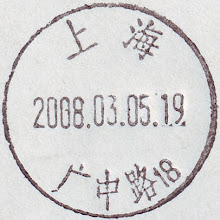
 Kaohsiung Temporary Post Office (TPO)
Kaohsiung Temporary Post Office (TPO)Name: Memory of Travel (Sweet)
TPO Open Date/Time: 2007 June 10th(96.6.10) (9:00-17:00)
Cancellation Design: Jimmy S.P.A
About Jimmy: Born in Taipei, B.A. in Fine Arts, with a major in Design. He had worked in advertising companies for 12 years. Now he works as an illustrator. Since 1998, Jimmy published several illustrated books with amazing originality and multi-faceted narratives. He had since set a fashion in creating and publishing illustrated books in local and international markets. Utilizing images as a refreshing form of literary language, Jimmy creates in his works poetic frames that emit charms and appeals. He has published seventeenth popular books so far, and they are translated into English, French, German, Greek, Japanese, Korean and so forth. Being the most popular illustrator author in Asia, creating lots of fantasy and touch hearts cross all generation, however, with low profile personality, he enjoys the family time more, lives a tranquil life and devotes most of his time to work. Immersing in his works is just like to go into Jimmy's inner world, his inviting stories reflect the reality of real life, more and more people are intoxicated by his vivid strokes and his magic realism narratives. Now in Asia, Jimmy becomes vogue of the time, beyond his stories, "Jimmy" is like a pop of a new life style.






































